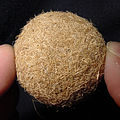Sea ball
Sea balls or sea balls are usually round, fibrous, felt-like structures that can be found on beaches around the world, where they can appear in large numbers , especially after spring and autumn storms. They are formed from the rhizome network of seaweed torn out by the movement of the water , the fibers of which are moved back and forth on the sandy bottom by waves and currents and thus become matted with one another. On Mediterranean beaches you can often find egg-sized sea balls made from the dead plant parts of the Neptune grass , which are therefore also known as Neptune balls .
Sea balls can be very different in size depending on the circumstances and the type of seaweed that occurs - usually between coin and tennis ball size . An elongated sea ball about 45 centimeters in diameter was found in Edgartown , Massachusetts .
Bruno Schröder differentiates fake sea balls, which are made of dead plant material and do not grow any further and which are usually referred to by the term sea ball today, from real sea balls such as Aegagropila linnaei , which are living organisms despite the ball shape.
Cultural history
The first descriptions of sea balls appear as early as 1216 by Moorish scholars in Andalusia who were interested in their medicinal effects. In the Economic Encyclopedia (1773 to 1858) the trade in sea balls for medicinal purposes at that time is reported: “It is often found in the Mediterranean Sea and brought to us from Venice, although it is also in the ocean, even in standing waters is to be found. What it is, and where it arises from, opinions are as varied as they are doubtful. Some think that it is made, others that it is a congealed meerschaum, and still others that it is produced in the stomach of a fish from the fibers of the reed that has been eaten, to which the latter opinion is mostly attributed. They are judged to have some medicinal use, and that is why they are run by the druggists and pharmacists; Today, however, they are used little more. ” According to Bruno Schröder, they were primarily used against goiters because of their iodine content , but also against skin diseases.
In the 19th century, too, the view was widespread that sea balls were created in the stomach of fish by swallowing indigestible seaweed, similar to bezoars , which can form from undigested hair in animal stomachs. Georg Hieronymus Welsch (1624–1677) referred to such a bezoar as Ægagropilus . The term Ægagropila for sea balls goes back to Carl von Linné , in Italian the term Egagropili for sea balls is still used today.
- Picture gallery
swell
- ↑ a b c d Bruno Schröder: About sea balls . In: The natural sciences . tape 8 , no. 41 , October 1, 1920, ISSN 0028-1042 , p. 799-803 , doi : 10.1007 / BF02450052 ( springer.com [accessed April 2, 2017]).
- ↑ Johann Georg Krünitz : Sea Ball. In: Economic Encyclopedia . University of Trier, UB, accessed on April 2, 2017 .
- ^ Buffon's Natural history , corrected and enlarged by J. Wright. 1831
- ↑ Velschius, Georgius Hieronymus [Georg Hieronymus Welsch] (1660) Dissertatio medico-philosophica de ægagropilis . Joannis Prætorii & Joannis Wehe Bibliopolæ .
Web links
- Die Sendung mit der Maus - Filzbällchen am Strand ARD, broadcast May 1, 2011, youtube.com, Nick Florian van der Linden, upload June 20, 2016. Accessed July 14, 2018. Video (7:05)




